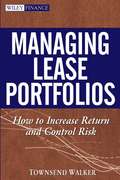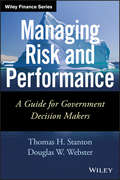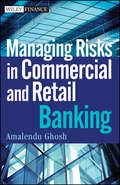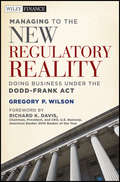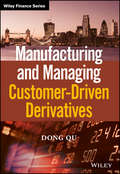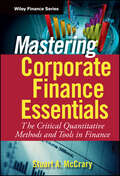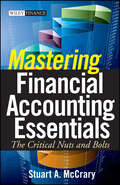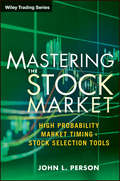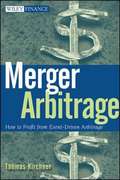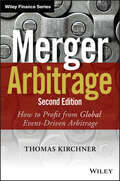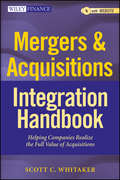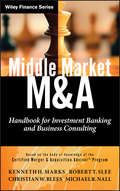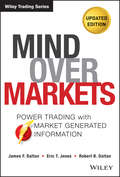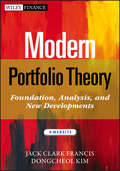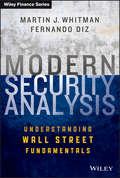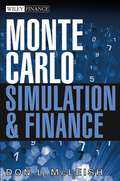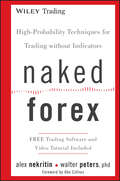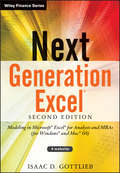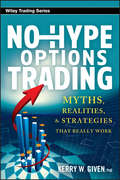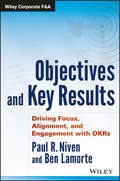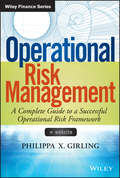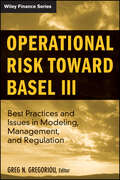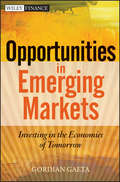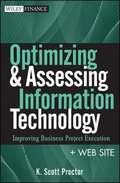- Table View
- List View
Managing Electronic Records
by Robert F. Smallwood Robert F. WilliamsThe ultimate guide to electronic records management, featuring a collaboration of expert practitioners including over 400 cited references documenting today's global trends, standards, and best practicesNearly all business records created today are electronic, and are increasing in number at breathtaking rates, yet most organizations do not have the policies and technologies in place to effectively organize, search, protect, preserve, and produce these records. Authored by an internationally recognized expert on e-records in collaboration with leading subject matter experts worldwide, this authoritative text addresses the widest range of in-depth e-records topics available in a single volume.Using guidance from information governance (IG) principles, the book covers methods and best practices for everything from new e-records inventorying techniques and retention schedule development, to taxonomy design, business process improvement, managing vital records, and long term digital preservation. It goes further to include international standards and metadata considerations and then on to proven project planning, system procurement, and implementation methodologies. Managing Electronic Records is filled with current, critical information on e-records management methods, emerging best practices, and key technologies.Thoroughly introduces the fundamentals of electronic records managementExplains the use of ARMA's Generally Accepted Recordkeeping Principles (GARP®)Distills e-records best practices for email, social media, and cloud computingReveals the latest techniques for e-records inventorying and retention schedulingCovers MS SharePoint governance planning for e-records including policy guidelinesDemonstrates how to optimally apply business process improvement techniquesMakes clear how to implement e-document security strategies and technologiesFully presents and discusses long term digital preservation strategies and standardsManaging e-records is a critical area, especially for those organizations faced with increasing regulatory compliance requirements, greater litigation demands, and tightened internal governance. Timely and relevant, Managing Electronic Records reveals step-by-step guidance for organizing, managing, protecting, and preserving electronic records.
Managing Lease Portfolios
by Townsend WalkerLeasing is one of today's more complex forms of financing, and, unless you have extensive experience in this arena, making informed decisions can be difficult. Over the life of a lease, its risks and returns change, and the factors that affect the risks and returns also change.In Managing Lease Portfolios, Townsend Walker, an expert in this field, explains how to evaluate the risk of lease portfolios as well as hedge their long-term, non-traded risks. Here, you'll learn how to apply various financial tools to your portfolio of leases and discover the work that goes into each step--such as measuring the risks of a lease, calculating the returns, and estimating the effects of diversification. Many of the ideas and concepts found within this comprehensive resource have existed for a number of years in the fields of foreign exchange, interest rate and credit derivatives, and the bond and stock markets. This book adapts and applies these concepts to managing leases. Then it illustrates how you can implement these new concepts through concrete models that have been proven to work in the real world.
Managing Risk and Performance
by Douglas W. Webster Thomas StantonDiscover analytical tools and practices to help improve the quality of risk management in government organizationsFederal agencies increasingly recognize the importance of active risk management to help ensure that they can carry out their missions. High impact events, once thought to occur only rarely, now occur with surprising frequency. Managing Risk in Government Agencies and Programs provides insight into the increasingly critical role of effective risk management, while offering analytical tools and promising practices that can help improve the quality of risk management in government organizations.Includes chapters that contribute to the knowledge of government executives and managers who want to establish or implement risk management, and especially Enterprise Risk Management (ERM), in their agenciesFeatures chapters written by federal risk managers, public administration practitioners, and scholarsShowing government officials how to improve their organization's risk management capabilities, Managing Risk in Government Agencies and Programs meets a growing demand from federal departments and agencies that find themselves increasingly embarrassed by risky events that raise questions about their ability to carry out their missions.
Managing Risks in Commercial and Retail Banking
by Amalendu GhoshA practical guide to the practices and procedures of effectively managing banking risks Managing Risks in Commercial and Retail Banking takes an in-depth, logical look at dealing with all aspects of risk management within the banking sector. It presents complex processes in a simplified way by providing real-life situations and examples. The book examines all dimensions of the risks that banks face--both the financial risks--credit, market, and operational--and the non-financial risks--money laundering, information technology, business strategy, legal, and reputational. Focusing on methods and models for identifying, measuring, monitoring, and controlling risks, it provides practical advice backed up by solid theories, without resorting to the use of complicated mathematical and statistical formulas. Author Amalendu Ghosh exposes topics that are usually absent in books on managing banking risk--such as design of control framework, risk management architecture, credit risk rating, risk-based loan pricing, portfolio analysis, business continuity planning, and corporate governance. Author has extensive experience with a variety of major banks and institutions worldwide and brings a fresh perspective in the wake of the global finance crisis Presents a novel approach using models of the credit risk rating of different types of borrowers, the methodology for assigning weights for deriving the rating, and the scoring process Covers the essentials of corporate governance and options for credit risk assessment in line with the recommendations made in the New Basel Capital Accord Explains the methodology of risk-based internal audit, including techniques to enable bank branches to switch over from the old transaction-based audit methods With its logical sequence of the aspects of risk management, the book's layout is ideal for presentations, making it a handy tool for risk management training
Managing to the New Regulatory Reality
by Gregory P. Wilson Richard K. DavisHow to manage and profit from the new financial regulatory realityNow, more than ever, navigating the new financial regulations is paramount for the survival of many large institutions. Managing to the New Regulatory Reality: Doing Business Under the Dodd-Frank Act provides the most important, need-to-know lessons for private sector management, boards of directors, policymakers, and even regulators, shedding light on the movement from crisis to panic, regulatory reform to winning under continuing financial regulatory uncertainty.Reviews the causes of 2008's financial crisis, and assesses its impact on multiple stakeholdersDescribes and analyzes the impact of the immediate U.S. and G20 policy and regulatory reactions on financial institutions that the crisis response triggeredExplains the legislative policies, and examines how institutions and the financial services industry can make these new policies and regulations work for themAll financial institutions, but especially large companies, will have to aggressively manage to the new regulatory reality. Managing to the New Regulatory Reality is the must-have survival guide to sustaining profitability despite all the new red tape.
Manufacturing and Managing Customer-Driven Derivatives (The Wiley Finance Series)
by Dong QuManufacturing and Managing Customer-Driven Derivatives Manufacturing and Managing Customer-Driven Derivatives sheds light on customer-driven derivative products and their manufacturing process, which can prove a complicated topic for even experienced financial practitioners. This authoritative text offers up-to-date knowledge and practices across a broad range of topics that address the entire manufacturing, pricing and risk management process, including practical knowledge and industrial best practices. This resource blends quantitative and business perspectives to provide an in-depth understanding of the derivative risk management skills that are necessary to adopt in the competitive financial industry. Manufacturing and managing customer-driven derivative products have become more complex due to macro factors such as the multi-curve environments triggered by the recent financial crises, stricter regulatory requirements of consistent modelling and managing frameworks, and the need for risk/reward optimisation. Explore the fundamental components of the derivatives business, including equity derivatives, interest rates derivatives, real estate derivatives, and real life derivatives, etc. Examine the life cycle of manufacturing derivative products and practical pricing models Deep dive into a wide range of customer-driven structured derivative products, their investment or hedging payoff features and associated risk exposures Examine the implications of changing regulatory standards, which can increase costs in the banking sector Discover practical yet sophisticated product analysis, quantitative modeling, infrastructure integration, risk analysis, and hedging analysis Gain insight on how banks should handle complex derivatives products Manufacturing and Managing Customer-Driven Derivatives is an essential guide for quants, structurers, derivatives traders, risk managers, business executives, insurance industry professionals, hedge fund managers, academic lecturers, and financial math students who are interested in looking at the bigger picture of the manufacturing, pricing and risk management process of customer-driven derivative transactions.
Mastering Corporate Finance Essentials
by Stuart A. MccraryAn essential guide to corporate finance Understanding corporate finance is a necessity for financial practitioners who struggle every day to find the right balance between maximizing corporate value and reducing a firm's financial risk. Divided into two comprehensive parts, Mastering Corporate Finance Essentials presents the material by example, using an extended scenario involving a new business formation. In Part One, present and future value mathematics are introduced followed by a number of applications using the tools. In Part Two, statistics as applied to finance are examined, with detailed discussions of standard deviations, correlations, and how they impact diversification. Through theory and real-world examples this book provides a solid grounding in corporate finance Other titles by Stuart McCrary include: Mastering Financial Accounting Essentials, How to Create and Manage a Hedge Fund, and Hedge Fund Course Covers the essential elements of this field, from traditional capital budgeting concepts and methods of valuing investment projects under uncertainty to the importance of "real-options" in the decision-making process This reliable resource offers a hands-on approach to corporate finance that will allow you to gain a solid understanding of this discipline.
Mastering Financial Accounting Essentials
by Stuart A. MccraryAn indispensable hands-on guide to financial accounting In light of recent accounting scandals, it is critical that all financial practitioners understand and play by the rules of the accounting field. Starting from the assumption that the reader is not familiar with any accounting jargon, Mastering Financial Accounting Essentials presents material in a way that explains the key features of modern accounting step by step and helps you develop an intuitive understanding of accounting. Each chapter presents important accounting concepts, from inventory valuation methods and the timing of erosion of productive assets to how internal managers calculate ratios and trends to evaluate business efficiency. For those who need to understand the language and law of this discipline in order to communicate effectively with accountants and clients, Mastering Financial Accounting Essentials will be an indispensable guide.
Mastering the Stock Market
by John L. PersonNoted technical analyst John Person outlines a comprehensive method to pinpointing today's best trading opportunitiesThe economy and stock market are heavily influenced by seasonal factors. For example, a strong holiday buying season tends to be bullish for retail stocks or rising energy costs hurt airline profitability. Awareness of seasonal trends in both the economy and stock market can put you in a better position to profit from sectors and stocks that are likely to outperform the overall market. And technical tools can then be used to confirm emerging trends and time entries into these stocks and sectors.Mastering the Stock Market provides authoritative insights into a method for trading stocks based on seasonal trends, sector analysis, and market timing. Taking a top-down approach, the book explains how seasonal supply/demand forces impact commodities and different sectors of the stock market. After learning how to identify stock market sectors and commodity ETFs that are ripe for a big move, you'll quickly discover how to use technical analysis to gauge the strength of the sector or commodity and then identify the strongest stocks and ETFs to trade. Along the way, you'll also learn how to use the author's own indicators, Persons Pivots, to identify support/resistance areas and pinpoint optimal entry and exit points.Outlines a proven technical approach for trading stocks based on seasonal trends, sector analysis, and market timingBreaks new ground in comparative relative strength, trading volume, breadth indicators, and utilizing pivot analysis in conjunction with options expiration days to identify trading opportunitiesWritten by noted technical analyst John L. PersonTo successfully trade today's markets you need to use a proven approach and have the discipline to effectively implement it. Mastering the Stock Market has what you need to achieve these goals and capture consistent profits along the way.
Merger Arbitrage
by Thomas KirchnerA detailed look at an important hedge fund strategy Written by a fund manager who invests solely in merger arbitrage, also referred to as risk arbitrage, and other event-driven strategies, Merger Arbitrage is the definitive book on how this alternative hedge fund strategy works. Initial chapters are dedicated to the ins and outs of the strategy-cash mergers versus stock for stock mergers, legal aspects of mergers, and pitfalls of the merger process-while later chapters focus on giving the reader sound advice for integrating merger arbitrage into an investment portfolio. Merger Arbitrage helps readers understand leverage and options, shorting stocks, and legal aspects of merger arbitrage, including seeking appraisal or filing lawsuits for inadequate merger consideration. For those looking to gain an edge in the merger arbitrage arena, this book has everything they need to succeed. Thomas F. Kirchner, CFA (New York, NY), is the founder and portfolio manager of Pennsylvania Avenue Funds (www. pennavefunds. com), which invests in merger arbitrage and other event-driven strategies.
Merger Arbitrage: How to Profit from Global Event-Driven Arbitrage
by Thomas KirchnerMitigate risk and increase returns with an alternative hedge fund strategy Merger Arbitrage: How to Profit from Event-Driven Arbitrage, Second Edition is the definitive guide to the ins and outs of the burgeoning merger arbitrage hedge fund strategy, with real-world examples that illustrate how mergers work and how to take advantage of them. Author Thomas Kirchner, founder of the Pennsylvania Avenue Event-Driven Fund, discusses the factors that drove him to invest solely in merger arbitrage and other event-driven strategies, and details the methods used to incorporate merger arbitrage into traditional investment strategies. And while there is always a risk that a deal will fall through, the book explains how minimal such risks really are when the potential upside is factored in. Early chapters of the book focus on the basics of the merger arbitrage strategy, including an examination of mergers and the incorporation of risk into the arbitrage decision. Following chapters detail deal structures, financing, and legal aspects to provide the type of in-depth knowledge required to execute an effective investment strategy. The updated second edition stresses new, increasingly relevant information like: Worldwide legal deal regimes UK takeover code UK takeover code global offspring Regulators around the world The book provides clear, concise guidance on critical considerations including leverage and options, shorting stocks, and legal recourse for inadequate merger consideration, allowing readers to feel confident about trying a new investment strategy. With simple benefits including diversification of risk and return streams, this alternative hedge fund strategy has a place in even the most traditional plan. Merger Arbitrage: How to Profit from Event-Driven Arbitrage, Second Edition provides the information that gives investors an edge in the merger arbitrage arena.
Mergers & Acquisitions Integration Handbook
by Scott C. WhitakerProven strategies and tactics to manage the integration of acquired and/or merged companies Mergers & Acquisitions Integration Handbook is a comprehensive resource to help companies create a scalable post merger or acquisition integration process and framework that accelerates operating and business benefit goal realization. Includes tools, templates, forms, examples and checklists to provide a no nonsense "handbook" style approach to managing an effective integration. Helps integration managers quickly get up to speed on various integration challenges, including guidance on developing detailed operational and functional integration plans to support flawless execution. Reveals how to avoid integration failure by establishing an in-house integration management office to handle integration projects. Includes a sample integration playbook that can be used to create a core competency within companies to support ongoing integration activity. Botched integration is the number one reason mergers fail. Mergers & Acquisitions Integration Handbook shows you how to develop, execute and implement merger integrations and business strategies to realize your organization's mergers and acquisitions goals.
Middle Market M & A
by Robert T. Slee Kenneth H. Marks Christian W. Blees Michael R. NallIn-depth coverage in a single handbook of the middle market based on the body of knowledge of the Certified M&A AdvisorTM credential programM&A advisors have an unprecedented opportunity in the middle market with the generational transfer of wealth and capital being deployed by private equity and corporate investors. Middle Market M&A: Handbook for Investment Banking and Business Consulting is a must-read for investment bankers, M&A intermediaries and specialists, CPAs and accountants, valuation experts, deal and transaction attorneys, wealth managers and investors, corporate development leaders, consultants and advisors, CEOs, and CFOs.Provides a holistic overview and guide on mergers, acquisitions, divestitures and strategic transactions of companies with revenues from $5 million to $500 millionEncompasses current market trends, activities, and strategies covering pre, during, and post transactionAddresses the processes and core subject areas required to successfully navigate and close deals in the private capital marketIncludes content on engagement and practice management for those involved in the M&A businessThis practical guide and reference is also an excellent primer for those seeking to obtain their FINRA Series 79 license.
Mind Over Markets
by James F. Dalton Robert B. Dalton Eric T. JonesA timely update to the book on using the Market Profile method to trade Emerging over twenty years ago, Market Profile analysis continues to realize a strong following among active traders. The approach explains the underlying dynamics and structure of markets, identifies value areas, price rejection points, and measures the strength of buyers and sellers. Unlike more conventional forms of technical analysis, Market Profile is an all-encompassing approach, and Mind Over Markets, Updated Edition provides traders with a solid understanding of it.Since the first edition of Mind Over Markets--considered the best book on applying Market Profile analysis to trading--was published over a decade ago, much has changed in the worlds of finance and investing. That's why James Dalton, a pioneer in the popularization of Market Profile, has returned with a new edition of this essential guide. Written to reflect today's dynamic market conditions, Mind Over Markets, Updated Edition clearly puts this unique method of interpreting market behavior and identifying trading/investment opportunities in perspective.Includes new chapters on Market Profile-based trading strategies, using Market Profile in connection with other market indicators, and much moreExplains how the Market Profile approach has evolved over the past twenty-five years and how it is used by contemporary tradersWritten by a leading educator and authority on the Market ProfileOne of the key elements that has long separated successful traders from the rest is their intuitive understanding that time regulates all financial opportunities. The ability to record price information according to time has unleashed huge amounts of useful market information. Mind Over Markets, Updated Edition will show you how to profitably put this information to work for you.
Modern Portfolio Theory
by Dongcheol Kim Jack Clark FrancisA through guide covering Modern Portfolio Theory as well as the recent developments surrounding itModern portfolio theory (MPT), which originated with Harry Markowitz's seminal paper "Portfolio Selection" in 1952, has stood the test of time and continues to be the intellectual foundation for real-world portfolio management. This book presents a comprehensive picture of MPT in a manner that can be effectively used by financial practitioners and understood by students.Modern Portfolio Theory provides a summary of the important findings from all of the financial research done since MPT was created and presents all the MPT formulas and models using one consistent set of mathematical symbols. Opening with an informative introduction to the concepts of probability and utility theory, it quickly moves on to discuss Markowitz's seminal work on the topic with a thorough explanation of the underlying mathematics.Analyzes portfolios of all sizes and types, shows how the advanced findings and formulas are derived, and offers a concise and comprehensive review of MPT literatureAddresses logical extensions to Markowitz's work, including the Capital Asset Pricing Model, Arbitrage Pricing Theory, portfolio ranking models, and performance attributionConsiders stock market developments like decimalization, high frequency trading, and algorithmic trading, and reveals how they align with MPTCompanion Website contains Excel spreadsheets that allow you to compute and graph Markowitz efficient frontiers with riskless and risky assetsIf you want to gain a complete understanding of modern portfolio theory this is the book you need to read.
Modern Security Analysis
by Martin J. Whitman Fernando DizA legendary value investor on security analysis for a modern eraThis book outlines Whitman's approach to business and security analysis that departs from most conventional security analysts. This approach has more in common with corporate finance than it does with the conventional approach. The key factors in appraising a company and its securities: 1) Credit worthiness, 2) Flows--both cash and earnings, 3) Long-term outlook, 4) Salable assets which can be disposed of without compromising the going concern, dynamics, 5) Resource conversions such as changes in control, mergers and acquisitions, going private, and major changes in assets or in liabilities, and 6) Access to capital.Offers the security analysis value approach Martin Whitman has used successfully since 1986Details Whitman's unconventional approach to security analysis and offers information on the six key factors for appraising a companyContains the three most overemphasized factors used in conventional securities investingWritten by Martin J. Whitman and Fernando Diz, Modern Security Analysis meets the challenge of today's marketplace by taking into account changes to regulation, market structures, instruments, and the speed and volume of trading.
Monte Carlo Simulation and Finance
by Don L. McleishMonte Carlo methods have been used for decades in physics, engineering, statistics, and other fields. Monte Carlo Simulation and Finance explains the nuts and bolts of this essential technique used to value derivatives and other securities. Author and educator Don McLeish examines this fundamental process, and discusses important issues, including specialized problems in finance that Monte Carlo and Quasi-Monte Carlo methods can help solve and the different ways Monte Carlo methods can be improved upon.This state-of-the-art book on Monte Carlo simulation methods is ideal for finance professionals and students. Order your copy today.
Naked Forex
by Alex Nekritin Walter PetersA streamlined and highly effective approach to trading without indicatorsMost forex traders rely on technical analysis books written for stock, futures, and option traders. However, long before computers and calculators, traders were trading naked. Naked trading is the simplest (and oldest) trading method. It's simply trading without technical indicators, and that is exactly what this book is about.Traders who use standard technical indicators focus on the indicators. Traders using naked trading techniques focus on the price chart. Naked trading is a simple and superior way to trade and is suited to those traders looking to quickly achieve expertise with a trading method.Offers a simpler way for traders to make effective decisions using the price chartBased on coauthor Walter Peters method of trading and managing money almost exclusively without indicatorsCoauthor Alexander Nekritin is the CEO and President of TradersChoiceFX, one of the largest Forex introducing brokers in the worldNaked Forex teaches traders how to profit the simple naked way!
Next Generation Excel
by Isaac GottliebTake Excel to the next level in accounting and financial modelingIn this new Second Edition of Next Generation Excel, Isaac Gottlieb shows financial analysts how to harness the full power of Excel to move forward into the new world of accounting and finance. Companies of all sizes use financial models to analyze their finances and plan business operations, as well as to create financial accounting reports like balance sheets, income statements, and statements of cash flows.While many businesspeople are quite familiar with the reports created with financial models, most are not as familiar with the creation of the models themselves. This book shows them how to build an accurate and effective financial model using the solid functionality and easy usability of Excel.Fully updated and revised to include support for Apple usersWritten by a professor of management and statistics who has taught the discipline for fifteen yearsAppropriate for professional financial analysts, as well as MBA studentsFor professionals and students whose responsibilities or studies include a full understanding of financial modeling, Next Generation Excel, Second Edition offers comprehensive training.
No-Hype Options Trading
by Kerry GivenA straightforward guide to successfully trading optionsOptions provide traders and investors with a wide range of strategies to lock in profits, reduce risk, generate income, or speculate on market direction. However, they are complex instruments and can be difficult to master if misunderstood.No-Hype Options Trading offers the straight truth on how to trade the options market. In it, author Kerry Given provides realistic strategies to consistently generate income every month, while debunking many myths about options trading that tend to lead retail traders astray. Along the way, he makes a conscious effort to avoid complex strategies that are appropriate only for market makers or professional traders, and instead focuses on low-risk strategies that can be easily implemented and managed by a part-time trader.Shows how you can use option spreads in conjunction with stocks to produce a regular stream of incomeEach chapter includes exercises to help you master the material presentedExamines how you can adjust option positions as market conditions change in order to maintain an optimal risk/reward profileWritten for anyone interested in successfully trading options, this reliable resource cuts through the hype and misinformation that surrounds options trading and presents a realistic path to profits.
Objectives and Key Results: Driving Focus, Alignment, and Engagement with OKRs
by Paul R. Niven Ben LamorteEverything you need to implement Objectives and Key Results (OKRs) effectively Objectives and Key Results is the first full-fledged reference guide on Objectives and Key Results, a critical thinking framework designed to help organizations create value through focus, alignment, and better communication. Written by two leading OKRs consultants and researchers, this book provides a one-stop resource for organizations looking to quantify qualitative goals and ensure each team focuses their efforts to make measureable progress on their most important goals. You'll learn how OKRs came to be and how leading companies use them every day to help teams and employees stretch their thinking about what's possible, build their goal-setting muscles and achieve results that reflect their full potential. From the basic framework to a detailed dissection of best practices, this informative guide walks you through real-world implementations to help you get the most out of OKRs. OKRs help employees work together, focus effort, and drive the organization forward. Key results are used to define what it means to achieve broad, qualitative goals, and imperatives like "do it better" are transformed into clear, measureable markers. From the framework's inception in the 1980s to its popularity in today's hyper-competitive environment, OKRs make work more engaging and feature frequent feedback cycles that enable workers to see the progress they make at work each and every day. This book shows you everything you need to know to implement OKRs effectively. Understand the basics of OKRs and their day-to-day use Learn how to gain the executive support critical to a successful implementation Maintain an effective program with key assessment tips Tailor the OKRs framework to your organization's needs Objectives and Key Results is your key resource for designing, planning, implementing, and maintaining your OKRs program for sustainable company-wide success.
Operational Risk Management
by Philippa X. GirlingA best practices guide to all of the elements of an effective operational risk frameworkWhile many organizations know how important operational risks are, they still continue to struggle with the best ways to identify and manage them. Organizations of all sizes and in all industries need best practices for identifying and managing key operational risks, if they intend on exceling in today's dynamic environment.Operational Risk Management fills this need by providing both the new and experienced operational risk professional with all of the tools and best practices needed to implement a successful operational risk framework. It also provides real-life examples of successful methods and tools you can use while facing the cultural challenges that are prevalent in this field.Contains informative post-mortems on some of the most notorious operational risk events of our timeExplores the future of operational risk in the current regulatory environmentWritten by a recognized global expert on operational riskAn effective operational risk framework is essential for today's organizations. This book will put you in a better position to develop one and use it to identify, assess, control, and mitigate any potential risks of this nature.
Operational Risk Toward Basel III
by Greg N. GregoriouThis book consists of chapters by contributors (well-known professors, practitioners, and consultants from large and well respected money management firms within this area) offering the latest research in the OpRisk area. The chapters highlight how operational risk helps firms survive and prosper by givingreaders the latest, cutting-edge techniques in OpRisk management. Topics discussed include: Basel Accord II, getting ready for the New Basel III, Extreme Value Theory, the new capital requirements and regulations in the banking sector in relation to financial reporting (including developing concepts such as OpRisk Insurance which wasn't a part of the Basel II framework). The book further discussed quantitative and qualitative aspects of OpRisk, as well as fraud and applications to the fund industry.
Opportunities in Emerging Markets
by Gordian GaetaThe practical guide to investing in emerging markets Though potentially risky, investing in emerging markets can offer extremely attractive returns. Opportunities in Emerging Markets offers practical advice for investors based on the real life experiences--both positive and negative--of practitioners, pioneer investors, and local heroes with experience in frontier markets. Exploring how every developing market has its own unique regional cultures and social structures that change the way investors invest, and must be understood in order to make wise investments, the book combines standard approaches to investing with the exigencies of frontier markets to create an invaluable framework for success. A collection of useful ideas that investors--institutions, general partners, limited partners, or shareholders--can draw upon when investing money in emerging markets, the book includes essential information on one of the most attractive opportunities for beating traditional markets and investments. If access, downside, and predictability can be managed, there's a great deal of money to be made in emerging markets, and this book shows how. Both investors and investment managers need to understand fundamental success factors, real framework conditions, and hidden pitfall and in Opportunities in Emerging Markets, author Gordian Gaeta analyses these intricacies in depth. Gives investors of all kinds the information they need to succeed in emerging markets Incorporates real life experiences--both good and bad--to help readers avoid common mistakes and maximize their returns Includes interviews with Mark Mobius, Jim Rogers, Marc Faber, and other leading names in the emerging markets sector For those traders brave enough to engage in high-risk/high-return investing, Opportunities in Emerging Markets is an excellent overview of the world's toughest frontier markets and how to conquer them. Featuring interviews with some of the top investors in the field, this is the definitive guide to the perils and pitfalls of investing in these highly volatile markets.
Optimizing and Assessing Information Technology
by K. Scott ProctorA valuable guide to making better IT decisions within businessOptimizing and Assessing Information Technology is designed to be both easy-to-use and immediately useful. Engaging and accessible, this book has been created to help you focus on improving business project execution through effective IT optimization and assessment. While it skillfully outlines a framework for optimizing and assessing IT, it does not get into specific technologies per se, given the rapid and increasing pace of technical change across the world today. Optimizing and Assessing Information Technology involves a step-by-step process whereby various aspects of IT are evaluated. In addition to the book itself, a companion website offers templates, checklists, and related materials for your reference and use. With this book as your guide, you'll be able to generate an accurate and reliable assessment of a company's IT operations and identify areas on which to focus to optimize IT. Topics such as "against what to assess operations" and "optimized as compared to what" will be addressed throughout the course of this reliable resource.Introduces the concept of the IT Pillars Model (IPM) for optimizing and assessing IT and examines where and how the IPM fits into the overall operations of a businessFilled with the author's experience of working across the field of IT in both small and large companiesOffers the most detailed, hands-on user's guide to the principles and practice of the IPM by examining each aspect of the IPM in the context of case studiesCovers the topic of tools and reporting, including analytical tools such as ROI, benchmarking, and metricsOptimizing and Assessing Information Technology provides valuable insights into this discipline, but the coverage of IT in this book extends beyond technology itself. It also covers various aspects of the people, processes, and technology components associated with IT as a whole.

